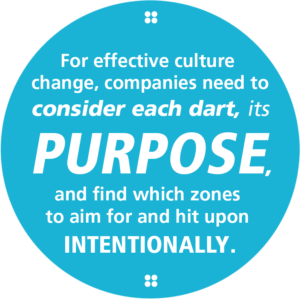
Imagine a dartboard, a handful of darts, and that tiny, red bullseye.
What do you do? Do you toss all of your darts at once and hope one lands, or throw one at a time with precision and care?
Believe it or not, this is how culture change is approached in many workplaces: leadership keeps trying to throw all the darts at once.
At a recent coffee meeting, a friend of mine was raving about a new training session to help win work… and yet he was struggling with how to make the change stick. As he was talking, I was thinking about one of our clients who hired us to help folks better connect with their customers and sell integrated value and delivery, not the lowest bid… yet who were also struggling to achieve positive permanent change.
Instead of thinking holistically about culture change and truly integrating the trainings to better support the desired change, my friend’s company, and my client’s, appear to suffer from overlapping or competing training sessions for employees in hopes that something works. In other words, too many darts all at once.
Here are the issues at hand:
 First, if a company throws a number of solutions—darts—at their workplace culture, it amounts to an overload of information and training for their employees. Due to this overwhelming volume, it’s difficult to pick and choose which language and practices to adopt.
First, if a company throws a number of solutions—darts—at their workplace culture, it amounts to an overload of information and training for their employees. Due to this overwhelming volume, it’s difficult to pick and choose which language and practices to adopt.- This then makes it difficult as an employee to believe, trust, or even have confidence in the concept of working hard at integrating these changes when they might be replaced at any time.
- Add to this that the employees probably suffer from training overload and are often stumped by the trouble that comes when training messages compete.
- Finally, if leadership is not owning the messages at the top and reinforcing that any given training should be taken seriously based on their own actions (not just what they are saying), then most folks just do what they are told when it comes to attending the session, but make no changes in their actual habits.
Culture change is so much more than a handful of darts. If a company takes its culture seriously, it must consider each miniature arrow, its purpose, and find which zones to aim for and hit upon intentionally.
And in truth, these darts are pointless unless a company takes its need for culture change seriously, and is honest about stepping up to the dartboard and seeking real change in the first place.